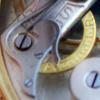Full Plate Movements And Pivot-Jewel Fitting
-
Recently Browsing
- No registered users viewing this page.
-
Topics
-
Posts
-
By Neverenoughwatches · Posted
Might that be the viscous nature of oil resisting gravity H , we have been comparing water and hydrophobic surfaces which are similar in principle but water is much less viscous than oil. I guess what we trying to discover is if epilame also has an adhesive trait as well as being oleophobic. -
But it also makes it seem less susceptible to gravity. If you place a droplet of oil on an epilame-treated surface the droplet of oil will still stay in place even if you then flip the surface from a horizontal to a vertical position. That is, the oil droplet remains anchored, and that's the purpose of epilame. If it was just a matter of creating an oleophobic surface we could probably use other, less expensive, methods!? I don't know @Waggy but my gut feeling tells me you're spot on (pun intended!). I believe the oleophobic property is a side effect of epilame which is designed to keep the oil anchored.
-
By Michael1962 · Posted
Saturday morning 27/4 Sunday evening 28/4 Monday evening 29/4 Floor has a drain in the middle so I am hoping that there is very little fall on it, if any. Room is about 2.5 x 2.5 metres square. Can only use about 1/2 of one wall on the right of the pictures which has a sliding glass door in it. And only about 3/4 of the wall to the left of the pictures as it has the door to the house in it. Progress. 🙂 -
By Neverenoughwatches · Posted
This makes much more sense now, the oil is withdrawing itself to make as little contact with the epilame as possible. Same principle as wax on a car creates a hyrophobic surface that makes the cohesive properties of water molecules pull together. The water beads run off only when under the influence of gravity but still remain cohesively beaded up. And as mentioned earlier a pivot would keep the oil in place on a cap jewel. Epilame on an escapement would be a different scenario, there is nothing to hold the oil in position if gravity tugs at the bead to move, plus the escape teeth pull the oil about Maybe this is why its suggested to run the watch for a short while to remove the epilame to make two oleophobic surfaces either side of the oil, creating a ring of fire 🔥 around it 😅 The oil is repelled by every surface of the epilame even that which it sits upon. So the oil pulls together to make as little contact with it as possible, but the oil cant float above that area, it can only sit there on top of it. Under gravity the oil could potentially run away as an oil bead, unless the epilame has an adhesive property which i dont think it does ? So something else keeps it in position ie a pivot under a cap jewel . But that isn't the case in a pallet jewel situation. -
As with every skill it watchmaking, it takes practice. Notice at the top of the document it says, "Practical work - 40 hours". I can get the balance wheels 'close enough' to flat, but never seem to get them perfect. Same with gear wheels. Guess I need more practice.
-









Recommended Posts